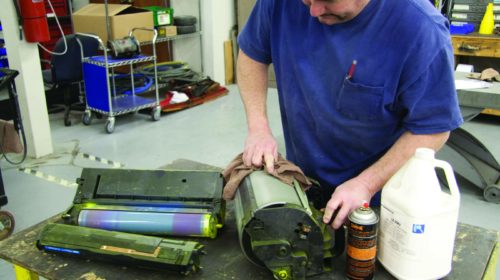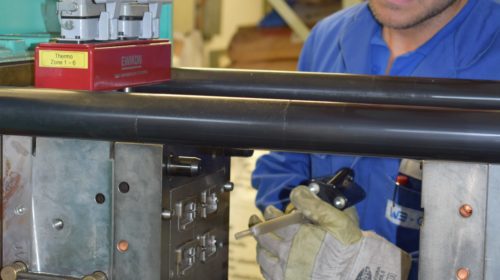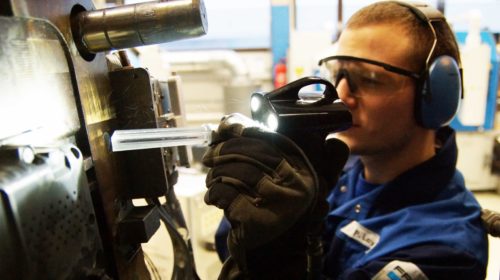
Automotive supplier experiences 50% reduction in mold maintenance costs
THE SITUATION
For Miniature Precision Components, Inc. (MPC) Corporate Headquarters in Walworth, Wisconsin and satellite facility in Prairie du Chien, Wisconsin, meeting customer expectations and providing them with a quality product the “first time, on time and all the time” is the company’s mission.
The company has won numerous quality awards and is currently ranked 40th in the industry. MPC is a supplier of functional thermoplastic injection assemblies and subassemblies for the automotive industry. Its customers include General Motors, Chrysler, Ford, Harley Davidson, Nissan and Toyota. As a leading thermoplastic components and assemblies manufacturer, MPC produces more than 450 different parts – manufacturing from thousands to millions of parts every year. To produce such a large volume of parts, the company must keep its machines running. The Prairie du Chien plant has 40 thermoplastic injection molding machines and a liquid silicone rubber (LSR) injection molding machine that use a variety of materials and polymers. To ensure that the company meets its customer deadlines – as well as high quality standards – the molding machines and molds must be maintained and cleaned regularly. After continuous use, the equipment and moldings become contaminated with degraded resin and gas residue among other contaminants. The press has to be shut down for the molds to be cleaned.
THE PROBLEM
If not cleaned regularly and properly, the off-gassing and degraded plastic resin can build up in the vents and the mold cavities, causing splays and burns. A rejected finished product could cost the company hundreds of thousands of dollars in lost labor expenses, defective parts and equipment damage. The molds are very expensive to replace, with one mold costing more than $80,000 while a small mold insert can cost up to $5,000.
Mike Wohlfarth, tooling engineer at MPC commented, “Our customers have come to expect nothing but high quality parts from MPC and given the competitive nature of the industry, they have no tolerance for defective parts. There is no margin for error, as replacing damaged equipment is expensive and a rejected part could cause MPC to lose the automotive customer.”
THE TRADITIONAL APPROACH
In the past, MPC used traditional cleaning methods such as chemical solvents, ultrasonic, abrasives and Scotch Brite cleansers to rid the equipment of contaminants. These manual methods were extremely hazardous and posed serious safety concerns to employees. Maintenance crews were subjected to harmful chemical fumes and had to work closely between two halves of hot molds, which can be heated to 275 degrees Fahrenheit when in use.
These cleaning methods were also time consuming. The production line had to be completely stopped and the molds had to be disassembled for cleaning. The disassembly as well as the cleaning methods and solutions placed the equipment at risk of potential damage. The cleaning chemicals would damage the equipment while the abrasives would remove steel on the parting line, causing flashing and resulting in a defective part. The Scotch-Brite cleaning solutions would also damage the mold surfaces, removing the base metal and rounding the sharp mold edges.
MPC needed a cleaning solution that could streamline and improve its cleaning methods.
After evaluating its cleaning processes, the company identified the following requirements for a new cleaning system:
- Eliminate the risk of damage to its molds;
- Reduce its dependency on chemical solvents;
- Decrease labor costs;
- Decrease preventive maintenance time;
- Increase production time and
- Clean molds online without exposing its employees to safety risks.
THE SOLUTION
After evaluating several cleaning solutions, the company turned to Cold Jet’s i3 MicroClean® precision dry ice cleaning system.
Dry ice cleaning is an innovative industrial cleaning process that is similar in concept to sand blasting. Rather than using an abrasive media, dry ice cleaning uses recycled carbon dioxide (CO2) in the form of dry ice pellets as its media.
Dry ice cleaning works by using compressed air to accelerate the soft recycled CO2 dry ice pellets at supersonic speeds. The dry ice has a temperature of -109 degrees Fahrenheit and when it hits the mold surface, it creates mini-explosions and sublimates. The combination of the kinetic energy and thermal shock gradient effects of dry ice cleaning breaks the bond between the surface and the residue.
Because the dry ice sublimates, there is no secondary waste to remove. The only thing left to clean up is the original surface contaminant, literally eliminating the added cost and inconvenience of secondary waste treatment and disposal. The fast, effective and non-abrasive cleaning method proved to be an ideal cleaning solution for MPC’s molds and equipment.
The i3 MicroClean is a portable tabletop system that can be transported directly to the equipment for cleaning. The system can clean small and delicate surfaces faster than traditional cleaning methods and without any abrasion or any required disassembly.
The i3 MicroClean features Cold Jet’s patented dry ice shaving technology, which allows companies to clean small to large applications using varying sizes of dry ice and custom nozzles that can project dry ice particles through a hole the size of pencil lead.
MPC uses Cold Jet’s i3 MicroClean with a finer nozzle for airbrushing the molds while they are offline and a flexible nozzle that allows the maintenance crew to clean hard to access spaces. For MPC, one to one and a half blocks of dry ice provide between 45 to 60 minutes of continuous cleaning power, which can clean the entire backside of a mold, compared to the three to four hours it previously took with scrubbing. MPC uses approximately 320 pounds of dry ice per week.
“The biggest advantage to using dry ice cleaning is safety,” added Wohlfarth. “We have to clean a number of machines and molds, which are all very hot while online. With dry ice cleaning, we have been able to clean the molds much faster than using chemicals – which has reduced downtime and increased productivity and employee safety.”
In addition to improving safety, the speed and efficiency of dry ice cleaning has allowed the company to reduce its cleaning time by 75% and, subsequently, its cleaning crew by more than 60%. Because dry ice cleaning is a dry process and non-conductive, cleaning crews can clean the large vertical mold while they are still online, without the risk of damaging equipment or electrical components.
The ability to clean online and at any time has increased cycles between scheduled preventive maintenance by 250% and reduced scheduled cleaning man hours by 81%.
“Dry ice cleaning definitely results in a superior clean and with less downtime, we have been able to increase production,” said Wohlfarth. “Our automotive customers have very stringent quality control procedures and demands and dry ice cleaning has helped us meet those part quality requirements. The detail of cleaning we get with Cold Jet’s system allows us to clean areas that otherwise could not be cleaned.”
Dry ice cleaning is a user-friendly process and promotes a safer, healthier work environment. Dry ice cleaning makes productive use of otherwise unproductive CO2, and is helping to reduce MPC’s dependency on harsh chemicals and dangerous cleaning practices that are often found in traditional cleaning methods.
Cleaning with dry ice is also helping to extend the life of MPC’s tooling by facilitating regular non-abrasive thorough cleaning and reducing machine disassembly. And possibly most important, clean molds help to eliminate defects and ensure high quality end products.
Since using dry ice cleaning, MPC has experienced a number of benefits, including:
- 40% reduction in its mold maintenance department, which has resulted in increased efficiency for superior results;
- 50% reduction in mold maintenance costs due to the elimination of the abrasives damaging the molds;
- Reduced press downtime;
- Significant reduction in defect levels in end products;
- Increased employee safety; and
- A return on investment in three months.
“Just three precision dry ice cleaning systems are all we need to clean our entire fleet of molds and equipment,” concluded Wohlfarth. “The process is quick, does not dull the tools and the portability of Cold Jet’s i3 MicroClean is a huge advantage as we can wheel it up to any machine in the plant for online cleaning. It has drastically improved our productivity and helped us cut costs. Simply put, dry ice cleaning is the best cleaning solution for our needs.”

